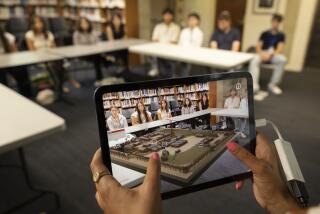Virtual Heritage Offers a Peek Into Past : History: Visit Pompeii, Stonehenge or wartime Dresden with a computer and a headset. Is this scholarship of the future, or just another video game that mixes fact, fantasy?
- Share via
BATH, England — Watch the sun rise over Stonehenge and try to decipher the centurions’ graffiti on its ancient pillars.
See Dresden Cathedral rise from the rubble of wartime Germany. Relive Pompeii in all its ancient glory before Vesuvius destroyed the Roman city.
In the world of Virtual Heritage, one simply straps on a headset and takes off in a time machine through history.
Artists and scientists have combined to help us walk through ancient sites armed only with a set of goggles and a soaring imagination.
To many, Virtual Reality means putting on that space age headset to zap aliens in computer games.
But its many uses range from designing new supermarkets to training commandos on how to combat terrorism. Film makers employ its technological tricks to dazzle movie fans.
Now it is the turn of the heritage industry and the possibilities are endless--as computer buffs demonstrated at what was billed as the world’s first Virtual Heritage conference.
Interactive students will never have to listen to dry lectures again. Instead they can enjoy living history.
Computer experts from around the world showed archeologists, museum curators, conservationists and town planners the technological miracles they could perform.
And the venue could not have been more appropriate--it was staged in the elegant Georgian town of Bath, which has been declared a World Heritage site by UNESCO.
“The world’s greatest museums and sites can be brought into your living room,” said U.S. researcher Eben Gay as he took the conference down the ramparts of the 4,500-year-old Egyptian fortress of Buhen, now under the floodwaters of the Aswan Dam.
“The only way you can visit it is in a computer re-creation,” he said.
The Lascaux Caves, the finest example of prehistoric art in Europe, have been closed to the public since 1961 because scientists say human breath is damaging the paintings.
Electronic artist Benjamin Britton from the University of Cincinnati can take you back underground in France down its magical corridors. Admiring the animals cavorting on its ancient walls, he said: “It takes us out of the realm of the mundane and into the realm of the extraordinary.”
History books came alive. Stonehenge is being rebuilt stone by computer stone as an educational and touristic tool for English Heritage, which runs the popular British monument.
Dresden’s Frauenkirche is being rebuilt both on the ground for real and by Virtual Heritage.
“You could say my life is in ruins,” said IBM consultant Brian Collins as he recounted the meticulous computer re-creation of the 18th Century baroque gem that was destroyed by fire after the Allied bombings of 1945.
Canadian researcher Rejean Baribeau showed how three-dimensional cameras can record artifacts inch by inch for virtual museums to retrieve and display.
From Split on the Adriatic to Edinburgh in Scotland, town planners can now work on “Virtual City” models to see what redevelopment would do to a historic old town.
Expert after expert enthused over how the world of Virtual Reality can combine education, tourism and science to enrich mankind and create jobs.
But are their wondrous creations all elaborate fakes that offer instant history but no academic accuracy?
Many said they were “economical with the truth” and borrowed from other eras or sites to complete a Virtual Heritage project.
They defended the use of artistic license. U.S. professor Lynn Holden of the Carnegie Mellon University argued that some adaptation was justified and inevitable.
More to Read
The biggest entertainment stories
Get our big stories about Hollywood, film, television, music, arts, culture and more right in your inbox as soon as they publish.
You may occasionally receive promotional content from the Los Angeles Times.










